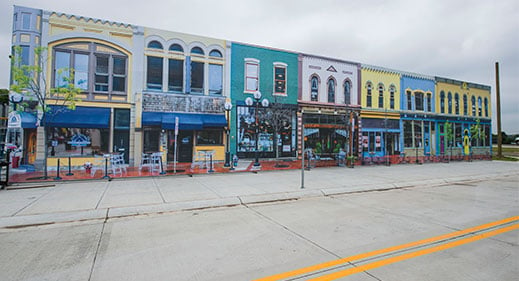A Ride Around Michigan’s Driverless City
The streets of a new neighborhood on the edge of Ann Arbor, Michigan, seem remarkably clean and peaceful. For automated cars, however, they represent daunting challenges.

The University of Michigan opened the area, called Mcity, this week, as a place for automotive companies and suppliers to test technology for automated and connected driving. The facility was built in collaboration with the Michigan Department of Transportation and with funding from numerous automakers and suppliers, who will have access to the area to test their technology in different situations.
Mcity is meant to include just about every possible traffic situation that could cause trouble for an automated car’s sensors and algorithms. Automated driving technology is improving, but computers still struggle with certain situations where visibility is degraded, where scenes are extremely complicated, or where there is a lot of other traffic that must be negotiated. The facility could also provide a good place for regulators to certify that different automated driving technologies meet the required standards (assuming such standards are established).
Across 32 acres of urban and suburban sprawl, Mcity includes traffic circles, tunnels, construction sites, highway on- and off-ramps, even faded lane markings and traffic signs defaced with graffiti. The snow that visits Michigan in winter should provide another important challenge (see “A Town Built for Driverless Cars”).
This week, companies with a stake in Mcity were there to showcase their technologies and give visitors a ride around the facility. For example, the mapping company Here, a division of Nokia, showed one of the cars it uses to scan streets with high-resolution cameras and laser ranging instruments. This data is valuable to automotive companies because it can help vehicles navigate along streets (recent reports, in fact, suggest Here may soon be acquired by a consortium of German carmakers). Here has scanned Mcity and made the data available to other companies.

Several automotive technology companies were at the launch. Denso, a Japanese component supplier, showed off hardware that allows cars to communicate with one another to help prevent accidents and congestion (see “10 Breakthrough Technologies: Car-to-Car Communications”).
The German supplier Bosch demonstrated a system that allows cars to drive for themselves on straight stretches of road. And Xerox and Honda showed a system that allows cars to detect and communicate with pedestrians or cyclists, via a suitably modified smartphone, to help prevent accidents.
Lorraine Novak, an application developer at Denso who also works on automated driving systems, said she was very keen to use Mcity to try different approaches to particular problems. She noted that traffic circles remain a big problem for automated cars. In busy traffic, self-driving cars, which are usually configured to be quite cautious, can end up going around a traffic circle many times before escaping, or they may simply come to a standstill, she says.
As automated driving becomes more common, bigger testing facilities may be required. Public officials and politicians in Michigan have also suggested that an even larger facility for testing self-driving vehicles could be developed about 20 minutes from Ann Arbor.
Keep Reading
Most Popular
Large language models can do jaw-dropping things. But nobody knows exactly why.
And that's a problem. Figuring it out is one of the biggest scientific puzzles of our time and a crucial step towards controlling more powerful future models.
How scientists traced a mysterious covid case back to six toilets
When wastewater surveillance turns into a hunt for a single infected individual, the ethics get tricky.
The problem with plug-in hybrids? Their drivers.
Plug-in hybrids are often sold as a transition to EVs, but new data from Europe shows we’re still underestimating the emissions they produce.
Stay connected
Get the latest updates from
MIT Technology Review
Discover special offers, top stories, upcoming events, and more.